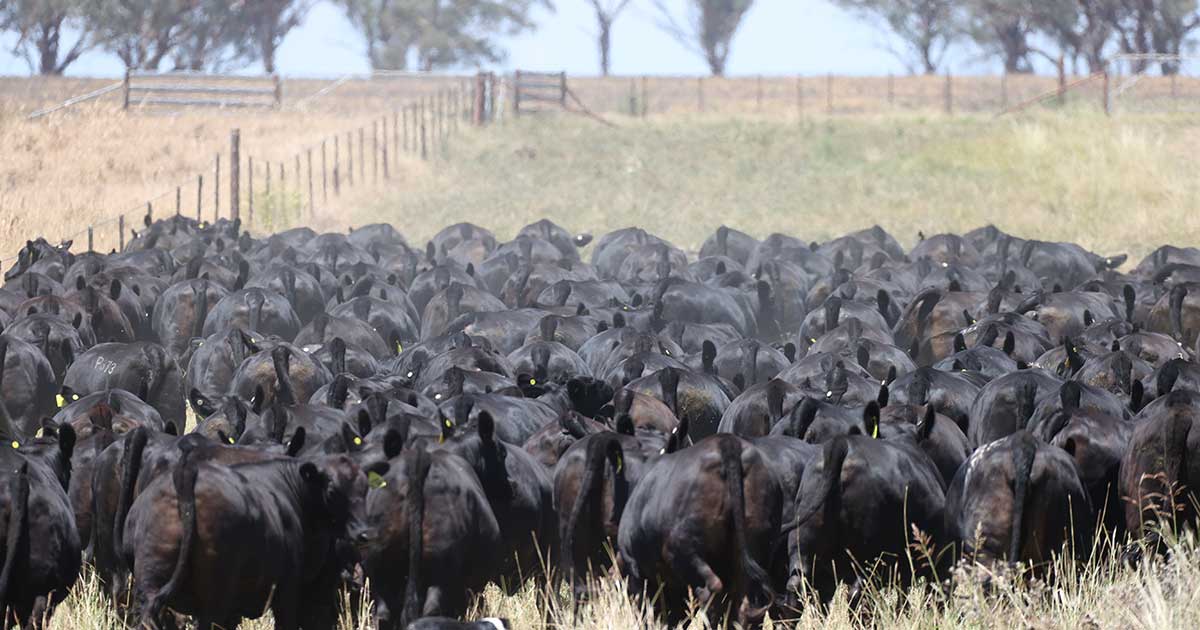Large Scale in Northern Australia


Accounting for over 50% of Australia’s cattle herd, Northern Australia’s increasing interest in the implementation of Angus genetics presents Angus breeders with significant opportunity.
As large-scale pastoral companies continue to explore methods to increase genetic improvement, productivity and profitability, Angus Australia Beef Australia seminar “Breeding for profitability in Northern Australia”, seeks to explore why Angus genetics are being selected for incorporation in traditionally bos indicus areas and understand the benefits that have been witnessed. During the seminar, attendees can expect to hear from Ben Noller from Palgrove Pastoral, Troy Setter from Consolidated Pastoral Co and Ian McLean from Bush AgriBusiness. To provide some background information on their operations, in the lead up to the seminar, we spoke with Ben Noller from Palgrove Pastoral and Troy Setter from Consolidated Pastoral Co.
Producing Angus genetics for the North – Palgrove Ultrablacks
Established in 1970, Palgrove has always had a strong focus on providing quality genetics for their clients, particularly in Northern Australia. Situated across southern QLD and northern NSW the company operates five properties and produces on average 1000 bulls per year.
Whilst originating as solely a Charolais stud, Angus genetics were introduced as a direct response to clients’ requests for a suitable third breed to be used in the traditional Charolais and Brahman crossbreeding operations of the North. Palgrove pioneered the development of the Ultrablack breed in 2009, which currently accounts for 70% of its bull sales.
Comprised of ~80% Angus genetics and 20% Brahman content, Ultrablack bulls are described as ‘Tropical Angus’ with a sleek coat, pliable hide and the constitution that comes from their ‘hint of Bos indicus’.
Palgrove prides itself on producing bulls that have the ‘meat eating quality of Angus in a heat tolerant package’ better suited to the Northern parts of Australia, where 70% of their clientele are situated.
Palgrove’s breeding objective emphasises a focus on body constitution and sleek coats to ensure survivability in the tough environments of Northern Australia. As well as improved fertility and meat quality to continue to aid their clients in improving productivity and profitability.
With a large proportion of Palgrove’s bull clientele marketing their herd’s progeny into southern feedlots or organic grass-fed production, the benefits of being able to meet grid requirements faster and achieve improved carcass quality attributes has seen many clients continue to return to the Ultrablack breeder. Further, producers have been pleased to report that the inclusion of Angus genetics to their production systems has enabled the ability to yearling mate their heifers.
Ben Noller, General manager, believes “Palgrove’s Ultrablack program is only just scraping the surface for the influence the breed will have on the Australian beef industry, with significant growth in bull sales in the last 3-5 years”.
The continued growth of the Palgrove Ultrablack program, and similar businesses has been demonstrated by the increase of Brangus and Ultrablack Multibreed registrations (MBR) with Angus Australia by an average 20% year on year, over the last 8 years.
Using Angus Genetics in the North – CPC
Operating a portfolio of nine station aggregations in Australia and two feedlots in Indonesia, the CPC team cares for more than 300,000 cattle and over 3.6 million hectares of Northern pastoral land across QLD, NT and Northern WA. CPC supplies both domestic and international customers, selling cattle to domestic feedlots, export processors, Asian consumer markets and live exporting cattle.
The vast majority of their QLD cattle are targeted towards 100 to 150 day lot fed markets but a smaller percentage are live exported to either Indonesia or Vietnam. In contrast cattle raised on CPC’s WA and NT property are most commonly live exported to the company’s feedlots in Indonesia, though some may be sent to QLD feedlots. Cattle are bred in an uncontrolled joining and are then preg-checked to segregate the cattle into similar calving brackets.
CPC aims to breed “fertile, productive cattle that create value, but are also economically as well as environmentally and animal welfare sustainable” according to CEO, Troy Setter.
Ensuring animals are selected for fast growth earlier in life, early maturity, improved fertility, sleek coats, reduced mature cow weight, feed conversion efficiency, meat quality and positive fat. Additionally, CPC places emphasis on increasing the survivability of their herd by selection criteria on body constitution and structure. As well as, producing heifers that are suitable for yearling joinings and do not miss a calf over their lifetime.
In 2015, CPC made the shift to increase the Angus content of their herd to, where it is today, between 25 and 50%. CPC sought to create a tropical composite, composed of Baran, Brahman, Wagyu and Angus, to capture the benefit of hybrid vigour particularly within the female herd’s fertility.
CPC have maintained the Bos indicus content of their herd to be able to manage the tick and heat load of the North and combat the tough nutritional conditions throughout the year. Angus genetics were primarily utilized to increase productivity, with rapid growth, improve the herd’s fertility and the company’s market options, as well as the conversion and weight gain of cattle at the feedlot. The incorporation of Angus genetics provided CPC with “predictable genetics” from “the large population of well measured and benchmarked genetics”. Further, the “depth and objectivity” within the Angus breed allowed management to have confidence in the selection process across a variety of traits from growth pattern and fertility to feed conversion and meat-eating quality.
As a result of the inclusion of Angus genetics, yearling heifer pregnancies have increased by 40% when compared to pure Brahman animals. Providing the opportunity for the company to continue to improve the percentage of yearling heifer pregnancies. Additionally, CPC have observed a 7% increase in branding rates between Angus influenced cattle and straight bred brahman.
Find out more
To hear more about the thriving success Palgrove and CPC are having by implementing Angus genetics come join us for the ‘Angus for every system – Breeding for profitability in Northern Australia’.
Hanlie Jansen, Extention Officer